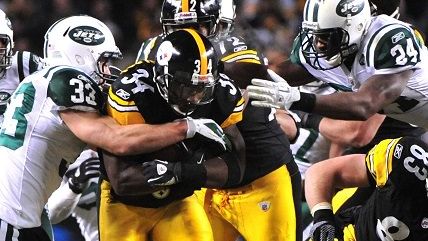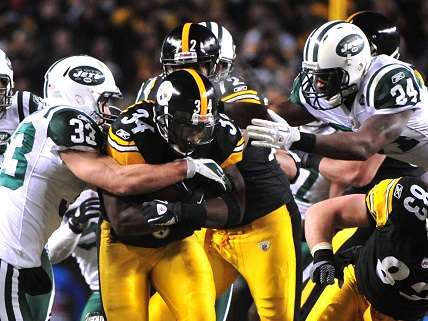Will the FCC Let Televised Football Be?
The micromanagement of pro football's television policies, it seems, will continue without interruption.


The Federal Communications Commission recently repealed a 1975 regulation banning cable and satellite operators from televising certain professional sporting events that were not otherwise made available to local broadcast stations. This regulation formed part of the so-called blackout rule enforced by the National Football League. Critics have long decried blackouts as the byproduct of special government privileges afforded the NFL. But the truth is a bit more complicated than that.
Article X and the Grim Decisions
On January 26, 1953, Justice Department lawyers opened the first—and to date only—government antitrust case against a professional sports league. The DOJ accused the NFL of maintaining an illegal "restraint of trade" through Article X of its bylaws. This article contained the original version of what is known as the "blackout rule," a league-wide policy governing the availability of games on television. Under Article X, adopted in 1951, no NFL game could be televised in the "home territory" of a club playing at home that same day. This included both the home club's game and any game played in another city. Article X did permit a team to televise its away games in its home market, and if it did so, no other NFL game could be broadcast in that same market.
In his opening statement before U.S. District Judge Allan K. Grim of Philadelphia, DOJ attorney W. Perry Epes said Article X illegally prevented local television stations from "satisfying the widespread public demand for broadcast and telecast of pro football games." Epes' co-counsel, John A. Skiles, added that the public "was entitled to all the benefits that might flow from open television and broadcasts of pro football."
The NFL responded that the blackout rules were necessary to protect home attendance. The NFL produced a seasonal product—the regular season only lasted 12 weeks back then—and any revenue earned from television rights would not make up for the lost gate if people chose to stay home in large numbers. And in any case, the NFL was a private business entitled to determine their own distribution practices.
Even the DOJ's Epes conceded individual NFL clubs had the right to refuse telecasts of their games. The government's antitrust challenge therefore targeted the clubs' decision to adopt a common television policy and delegate control of their television rights to then-NFL Commissioner Bert Bell. In November 1953, Judge Grim, who tried the government's case without a jury, issued his decision.
He largely upheld Article X. He said the NFL had a legitimate interest in protecting the home attendance of its clubs, especially the weaker ones, by keeping games off local television. But he struck down Article X's restrictions on televising games in a market where no home team was playing, as well as the delegation of authority to Commissioner Bell to disapprove television contracts. Those provisions, Grim said, did not advance the NFL's goal of protecting home attendance.
By the early 1960s, the market for televised sports had changed significantly. A new football league, the American Football League, had formed and signed a national television contract with NBC. The NFL attempted to follow suit. In April 1961 the NFL signed a deal giving CBS the exclusive right to televise all league games throughout the country (still subject to the home-blackout rule). Although nearly eight years had passed, Judge Grim retained jurisdiction over the NFL's television policy, and in July 1961, he ruled the CBS contract violated his 1953 decision. Basically, Grim said the NFL clubs could no more delegate their television rights to CBS as a common agent than it could the commissioner's office.
This put the NFL on an unfair playing field relative not just to the AFL, but every other professional sports league. Indeed, both the NBA and NHL had signed similar national television contracts during the 1950s without facing a government antitrust challenge. Nor had the DOJ attacked the NCAA's even more restrictive television policy, which kept most college football games off of television until a 1984 Supreme Court decision.
The NFL therefore lobbied Congress to remedy the problem caused by the intervention of the DOJ and Judge Grim. The result was the Sports Broadcasting Act of 1961 (SBA), which granted all leagues, not just the NFL, antitrust immunity when signing national television contracts. Critics would later describe this as a "monopoly privilege" granted to the NFL, but in truth it was restoring the market that existed prior to the DOJ's selective enforcement of the antitrust laws.
Special Privileges for College Football
However, Congress did impose one special condition on the NFL alone. SBA prohibited the NFL from exercising its national contract rights to televise any game after 6:00 p.m. on Friday and all day Saturday if there were any college (or high school) football games being played within a 75-mile radius of the television station scheduled to broadcast the game. This provision was inserted after lobbying from the National Collegiate Athletic Association (NCAA), which was not content to simply keep its own members' games off television; it also demanded the government keep the NFL away as well.
The Friday-Saturday restriction continues to this day. This partially explains the NFL's 2006 decision to launch a Thursday Night Football package—Friday and Saturday nights being off-limits—and even forces the league to minimize telecasts of games rescheduled due to emergency. For example, a September 2004 Miami Dolphins-Kansas City Chiefs game was moved from Sunday to Saturday due to an approaching hurricane. SBA forced the NFL to keep the game off of national television. It was only telecast locally in Miami and Kansas City after the league obtained waivers from all colleges and high schools playing football games within a 75-mile radius of the local CBS affiliates.
Again, it's important to emphasize that the government only imposes these blackout restrictions on the NFL. The NBA is perfectly free to televise games nationally at the same time as NCAA basketball matches. And even the NFL's current Thursday night package competes against college football games without incident.
Congress and the FCC Further Muddy the Waters
The NFL continued to black out all home games through the 1960s and early 1970s. But the development of cable television posed a new challenge for the league. In December 1972, a cable system in West Palm Beach, Florida, petitioned the FCC for permission to carry an out-of-town feed of Miami Dolphins games, which of course were blacked out by the local NBC affiliate. The FCC refused permission, in effect requiring the cable system to honor the blackout negotiated by the NFL and the network.
The following year, President Nixon—irate over the lack of Redskins games on local television—and members of Congress decided to renew the federal government's War on Blackouts. In September 1973, Congress amended the FCC's enabling statute to limit the NFL's ability to enforce blackouts through its television contracts. Under the new law, the NFL could only black out home games if they were not sold out within 72 hours of kickoff. This law actually expired in December 1975, but the NFL has kept the 72-hour rule in effect to this day.
Meanwhile, the FCC continued to deal with the issue of cable systems. In 1975, the commission adopted its own blackout rule, which effectively codified its 1972 decision banning cable (and satellite) operators from importing out-of-market signals to get around blackouts agreed upon by the NFL and its broadcast network partners.
The FCC did not adopt this rule to help the NFL so much as local television stations. Historically, the FCC's mission has been to promote and protect local television stations—which, after all, receive their licenses from the FCC and depend on advertising revenue for their success. By extending NFL blackouts to cable operators, the FCC was merely continuing its favored policy of "localism" against outside encroachment.
The comedy in all this is the DOJ's original 1951 lawsuit against blackouts had the same objective. During the second week of the trial before Judge Grim, DOJ attorney Walter Murphy read into the record notes from a 1951 NFL meeting where a league owner said a television station owner "threatened him with Justice Department prosecution for forbidding" the right to televise games. In other words, broadcasters lobbied the DOJ to sue the NFL, not to protect some vague "public interest," but simply to gain access to potentially lucrative local programming.
Blackouts Mask the Real Problem
The FCC's recent decision to abolish its own blackout rule was accompanied by a good deal of free-market rhetoric. FCC Commissioner Ajit Pai, a Republican, said in his statement, "I don't believe the government should intervene in the marketplace and help sports leagues enforce their blackout policies." Yet the government has spent more than 60 years intervening in one form or another, starting with the original DOJ lawsuit.
One consequence of that lawsuit was the NFL became politically active. It developed the lobbying savvy to gain passage of SBA in 1961. More importantly, the NFL learned to adopt the "public interest" mantra in securing stadium subsidies from local government. After all, if the government must intervene in the market to get football on television, why not extend that intervention to include building multi-billion stadiums that bring jobs and badly needed tax revenue to local governments?
In fact, the NFL and its allies point to heavily subsidized stadiums as proof of the continuing need for the blackout rule. It may surprise some readers to learn the FCC received pro-blackout comments from liberal interest groups like the AFL-CIO and Jesse Jackson's Rainbow PUSH Coalition. The AFL-CIO argued union members "depend on the business generated by fans attending sold-out games for income to support their families." The Rainbow PUSH Coalition also pointed to the "jobs and economic development" created by government-financed stadiums as justification for the blackout rule.
Of course, as economist J.C. Bradbury told Reason's Nick Gillespie last year, stadium subsidies are really "just a transfer from locals" that merely create the illusion of economic growth. Bradbury noted politicians—a group dominated by "upper-income educated males" who are "huge sports fans"—are especially in love with these subsidies "because everyone seems to like sports."
And yet, subsidized stadiums are often less attractive to football consumers than staying home and watching the game on television. While high-definition sets continue to increase in quality and decrease in price, NFL stadiums are doing just the opposite. Fans are priced out of "luxury" seats in stadiums that require too much travel time.
The NFL recognizes this problem. That is why, despite the recent publicity over the FCC ending its support for the blackout rule, the league has been slowly easing its own enforcement of the policy. In 2012, the NFL said teams could voluntarily "lift" a home blackout if it sold just 85 percent of its tickets. And the NFL only reported two blackouts during the 2013 season, an all-time low.
Still, the NFL's slow blackout retreat is not enough for some political meddlers. Sens. John McCain (R-Ariz.) and Richard Blumenthal (D-Conn.) recently threatened to amend the SBA to require the NFL to abolish blackouts once and for all. The micromanagement of pro football's television policies, it seems, will continue without interruption.


Show Comments (39)